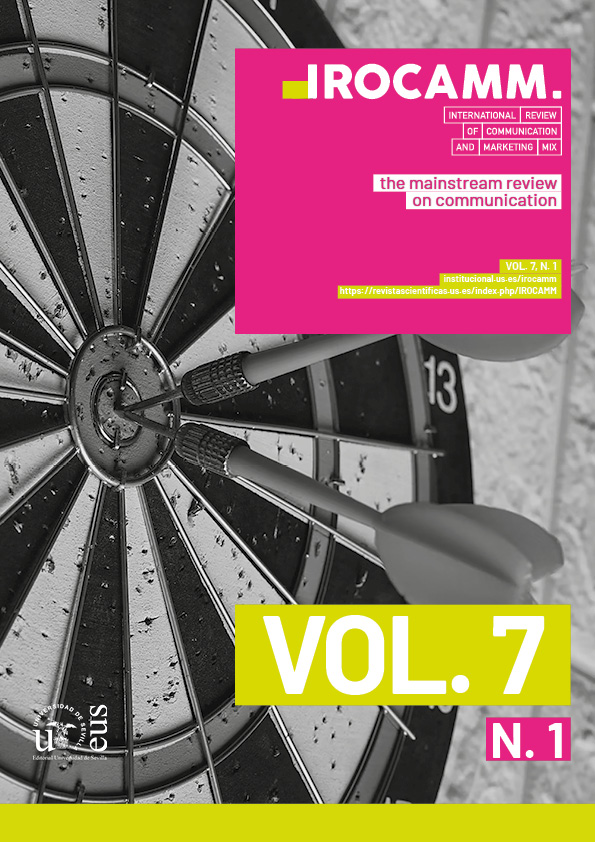Résumé
Este estudio examina las percepciones de jóvenes universitarias en Perú sobre los discursos de género y empoderamiento femenino presentes en la publicidad. A través de un enfoque cualitativo, se exploran las interpretaciones y reacciones de estas jóvenes ante la representación del género en la publicidad, enfocándose en identificar los elementos que influyen en sus percepciones de autenticidad y oportunismo. El análisis revela que, dentro de estas percepciones, emerge el fenómeno del femvertising como una preocupación significativa, donde se cuestiona la sinceridad de las marcas en su compromiso con el empoderamiento femenino. Este hallazgo subraya la complejidad de la relación entre publicidad, género y cultura en el contexto peruano.
Références
Abitbol, A., & Sternadori, M. (2019). Championing women’s empowerment as a catalyst for purchase intentions: Testing the mediating roles of OPRs and brand loyalty in the context of femvertising. International Journal of Strategic Communication, 13(1), 22–41. https://doi.org/10.1080/1553118X.2018.1552963
Åkestam, N., Rosengren, S., & Dahlen, M. (2017). Advertising “like a girl”: Toward a better understanding of “femvertising” and its effects. Psychology and Marketing, 34(8), 795–806. https://doi.org/10.1002/mar.21023
Aksakal, M., & Schmidt, K. (2015). German country report on semi-structured interviews with temporary migrants: Asian-German transnational spaces-report for the EURA-NET project. https://pub.uni-bielefeld.de/record/2901514
Arellano Marketing. (2017). Estilos de vida: Las Modernas. https://www.arellano.pe/los-seis-estilos-de-vida/las-modernas/
BBC News Mundo. (2019, Marzo 5). Google: lo que revela el polémico análisis de igualdad salarial del gigante tecnológico entre hombres y mujeres. BBC News Mundo. https://www.bbc.com/mundo/noticias-47458780
Baxter, A. (2015). Faux Activism in Recent Female-Empowering Advertising. The Elon. Journal of Undergraduate Research in Communications, 6(1), 48–58. http://www.inquiriesjournal.com/a?id=1133
Becker-Olsen, K., Cudmore, B., & Hill, R. (2006). The impact of perceived corporate social responsibility on consumer behavior. Journal of Business Research, 59(1), 46–53. https://doi.org/10.1016/j.jbusres.2005.01.001
Becker-Herby, E. (2016). The Rise of Femvertising: Authentically Reaching Female Consumers [Master’s thesis, University of Minnesota]. https://hdl.handle.net/11299/181494
Belknap, P., & Leonard, W. M. (1991). A conceptual replication and extension of Erving Goffman’s study of gender advertisements. Sex Roles, 25(3-4), 103–118. https://doi.org/10.1007/BF00289848
Berger, J. (2023). Modos de ver. Fósforo.
Biernacki, P., & Waldorf, D. (1981). Snowball Sampling: Problems and Techniques of Chain Referral Sampling. Sociological Methods & Research, 10(2), 141–163. https://doi.org/10.1177/004912418101000205
Collins Jr, G. E., Wilson, E., Luo, M., & Surmeier, A. (2016). BIC Pens For Her. https://digitalcommons.murraystate.edu/scholarsweek/Fall2016/MME/2/
Creswell, J. (2003). 179 research Design: Qualitative. Quantitative and Mixed Methods. https://www.ucg.ac.me/skladiste/blog_609332/objava_105202/fajlovi/Creswell.pdf
Cwynar-Horta, J. (2016). The commodification of the body positive movement on Instagram. Stream: Culture/Politics/Technology, 8(2), 36–56.
Czerniawski, A. M. (2022). “Real” bodies in plus-size fashion. Fat Studies, 11(3), 231–243. https://doi.org/10.1080/21604851.2021.1913827
Fox-Kirk, W., Gardiner, R. A., Finn, H., & Chisholm, J. (2020). Genderwashing: The myth of equality. Human Resource Development International, 23(5), 586–597. https://doi.org/10.1080/13678868.2020.1801065
García-Jiménez, J. V., Ruiz-de-Maya, S., & López-López, I. (2017). The impact of congruence between the CSR activity and the company’s core business on consumer response to CSR. Spanish Journal of Marketing-ESIC, 21(s1), 26–38. https://doi.org/10.1016/j.sjme.2017.01.001
Garrido, R. (2020). El ‘body positive’ e Instagram, ¿Es compatible promover el amor propio en la red social del culto al cuerpo? 20 minutos. https://www.20minutos.es/noticia/4344411/0/el-body-positive-e-instagram-es-compatible-promover-el-amor-propio-en-la-red-social-del-culto-al-cuerpo/
Gerard, K. (2019). Rationalizing “gender-wash”: Empowerment, efficiency and knowledge construction. Review of International Political Economy, 26(s5), 1022–1042. https://doi.org/10.1080/09692290.2019.1625423
Illouz, E. (2020). El fin del amor: una sociología de las relaciones negativas (Vol. 3104). Katz Editores.
Inglehart, R. (1997). Modernization and postmodernization: Cultural, economic, and political change in 43 societies. Princeton University Press. https://doi.org/10.2307/j.ctv10vm2ns
Jiménez-Marín, G., Simancas-González, E., & González-Oñate, C. (2022). La publicidad: Estructura de la industria en España. Del cliente a la agencia (y viceversa). Pirámide.
Kent, M. (2015). The power of storytelling in public relations: Introducing the 20 master plots. Public Relations Review, 41(4), 480–489. https://doi.org/10.1016/j.pubrev.2015.05.011
Mamuric, N. (2019). Femvertising: Advertising taking social responsibility to sell brands. Journal of Brand Strategy, 7(4), 318–325.
Menéndez, M. I. (2020). «You’re made of what you do»: Impulso del deporte femenino a través de estrategias de femvertising en Nike. Retos: nuevas tendencias en educación física, deporte y recreación, 38, 425–432. https://doi.org/10.47197/retos.v38i38.76959
Mensa, M., & Grow, J. M. (2023). Women are survivors: Public services announcements on violence against women in Latin America. Violence Against Women, 29(6-7), 1252–1274. https://doi.org/10.1177/10778012221104509
Palomo-Domínguez, I., Jiménez-Marín, G., & Valenzuela, N. S. G. (2023). Social Media Strategies for Gender Artivism: A Generation of Feminist Spanish Women Illustrator Influencers. Information & Media, 98, 23–52. https://doi.org/10.15388/Im.2023.98.61
Saldaña, J. (2011). Fundamentals of qualitative research. Oxford University Press.
Sánchez-Riaño, V., Arango Lozano, C. A., & Sojo-Gómez, J. R. (2022). Centennials: La búsqueda del ser en un universo digital. IROCAMM -. International Review Of Communication And Marketing Mix, 5(1), 9–20. https://doi.org/10.12795/IROCAMM.2021.v05.i01.01
Saucedo Espinosa, F., & Sánchez Garza, J. A. (2021). Periodismo digital: Reconfigurando los modelos de negocio y representando un nicho de mercado para emprendedores. IROCAMM -. International Review Of Communication And Marketing Mix, 2(4), 81–92. https://doi.org/10.12795/IROCAMM.2021.v02.i04.07
Simancas González, E. (2019). La formación feminista como arma para combatir la publicidad sexista. Hachetetepé. Revista científica de educación y comunicación, (18), 47–59. https://doi.org/10.25267/Hachetetepe.2019.v1.i18.6
Sterbenk, Y., Champlin, S., Windels, K., & Shelton, S. (2022). Is Femvertising the New Greenwashing? Examining Corporate Commitment to Gender Equality. Journal of Business Ethics, 177, 491–505. https://doi.org/10.1007/s10551-021-04755-x
Vandellos, E., Villarroya, A., & Boté-Vericad, J.-J. (2023). ¿Qué sabemos de la femvertising? Una revisión sistemática de la literatura. Cuadernos.Info, (56), 185–205. https://doi.org/10.7764/cdi.56.61527
Varghese, N., & Kumar, N. (2020). Feminism in advertising: Irony or revolution? A critical review of femvertising. Feminist Media Studies, 22(2), 1–19.
Walters, R. (2021). Varieties of gender wash: Towards a framework for critiquing corporate social responsibility in feminist IPE. Review of International Political Economy, 29(5), 1–24.
Windels, K., Champlin, S., Shelton, S., Sterbenk, Y., & Poteet, M. (2019). Selling Feminism: How Female Empowerment Campaigns Employ Postfeminist Discourses. Journal of Advertising, 49(1), 1–16.

Cette œuvre est sous licence Creative Commons Attribution - Pas d'Utilisation Commerciale - Partage dans les Mêmes Conditions 4.0 International.
© IROCAMM - International Review Of Communication And Marketing Mix 2023

